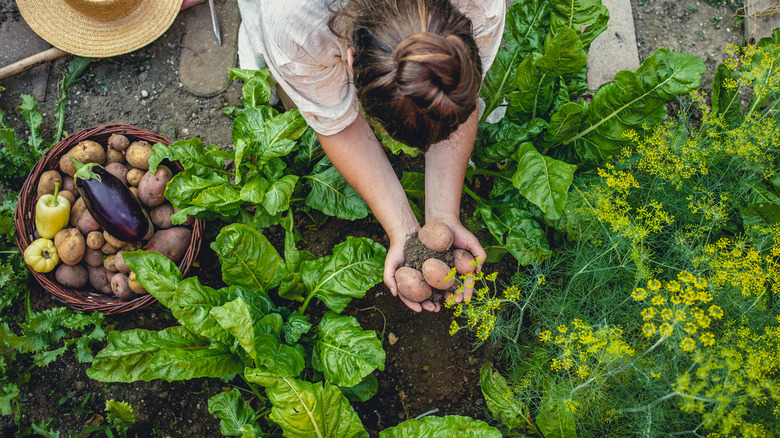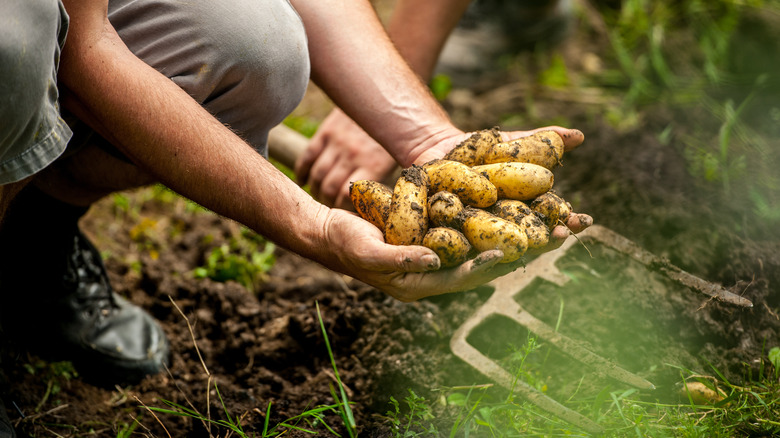The Helpful Tip That Will Ensure A Bountiful Potato Harvest
Growing potatoes in your garden can be an exciting and unique experience because it differs from other typical garden vegetables like tomatoes or peppers. For potatoes, the best tip for a bountiful harvest is to use the "hill" method – burying the exposed stem of the plant as it grows above the soil to create more roots for potato growth. To try this method, begin by selecting a suitable planting location with well-drained soil and full sunlight. Prepare the soil by loosening it to a depth of about 8 inches and incorporating organic matter, such as compost or aged manure, to improve soil fertility and structure.
Next, prepare the seed potatoes for planting by cutting them into pieces, ensuring that each piece contains at least one eye or sprout. Allow the cut pieces to dry and callus for a day or two before planting to reduce the risk of rot. Once the seed potatoes are ready, plant them in shallow trenches or furrows spaced about 18 inches apart and 3 to 4 inches deep. Place the seed potatoes with the cut side down and the eyes facing upward. Cover the seed potatoes with a few inches of soil, leaving some space to add more soil later as the plants grow. As the potato plants emerge and grow, gradually mound soil around the base of the plants to form hills or ridges. Continue this process every few weeks, building up the soil around the stems until the plants are completely covered.
Why this method works
If you're ready to elevate your potato game, then you need to try hilling. The hill method of growing potatoes is a time-tested technique that has proven to yield bountiful harvests. One reason it works so well is that the hill method promotes optimal soil aeration and drainage. By elevating the plants on mounds, excess water is less likely to accumulate around the roots, reducing the risk of rot and fungal diseases. Additionally, the loose, well-drained soil in the hills allows oxygen to reach the roots more efficiently, facilitating nutrient uptake and overall plant health.
Secondly, hilling helps to control weeds. As the potato plants grow, the mounded soil smothers weeds, reducing competition for nutrients, water, and sunlight. This minimizes the need for manual weeding and ensures that the potato plants can thrive without interference from invasive vegetation. Furthermore, the hill method encourages the development of additional tubers along the buried stems. As the potato plants grow upward, more stems are buried beneath the mounded soil. Each buried stem has the potential to produce additional potatoes, resulting in higher yields per plant.
Lastly, the hilled soil provides insulation and protection for the developing tubers. As the potatoes grow, the surrounding soil helps shield them from fluctuations in temperature and sunlight, preventing greening and maintaining optimal growing conditions. Therefore, you'll not only be increasing your overall potato harvest, but you'll have healthy, delicious potatoes for your culinary adventures, too.
When to harvest your potatoes from this method
Determining when to harvest potatoes planted using the hill method involves observing several key signs. Typically, potatoes are ready to be harvested about 2-3 weeks after the plants have finished flowering. One indication of readiness is the withering and yellowing of the foliage. As the plant matures, its leaves start to die back, signaling that the tubers have reached maturity underground. Additionally, the skin of mature potatoes becomes firm and set, rather than easily damaged or punctured.
When harvesting potatoes from the hill method, start by gently removing the foliage from the plant, being careful not to damage the tubers beneath the soil. To harvest the potatoes, carefully dig around the base of the plant with a garden fork or shovel, loosening the soil and exposing the tubers. Take care not to stab or pierce the potatoes while digging. Once the tubers are exposed, gently lift them from the soil, being mindful not to bruise or injure them. It's best to harvest potatoes on a dry day to minimize the risk of soil sticking to the tubers, which can encourage rotting during storage.
After harvesting, brush off any excess soil from the potatoes, but avoid washing them until just before use. Store the harvested potatoes in a cool, dark, and well-ventilated place to prolong their shelf life. Properly cured and stored potatoes can last for several months, providing a delicious and nutritious addition to meals throughout the year.

